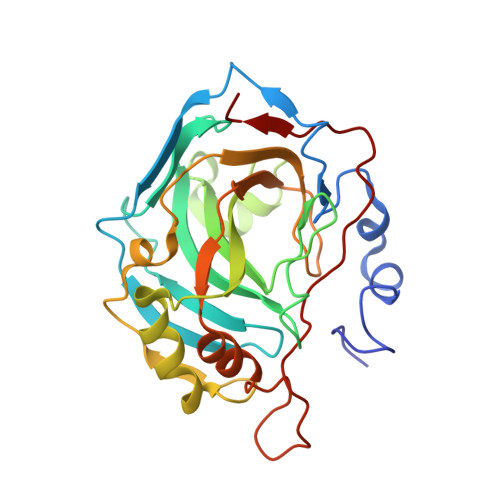Atomic resolution studies of carbonic anhydrase II.
Behnke, C.A., Le Trong, I., Godden, J.W., Merritt, E.A., Teller, D.C., Bajorath, J., Stenkamp, R.E.(2010) Acta Crystallogr D Biol Crystallogr 66: 616-627
- PubMed: 20445237
- DOI: https://doi.org/10.1107/S0907444910006554
- Primary Citation of Related Structures:
1LUG, 3K34 - PubMed Abstract:
Carbonic anhydrase has been well studied structurally and functionally owing to its importance in respiration. A large number of X-ray crystallographic structures of carbonic anhydrase and its inhibitor complexes have been determined, some at atomic resolution. Structure determination of a sulfonamide-containing inhibitor complex has been carried out and the structure was refined at 0.9 A resolution with anisotropic atomic displacement parameters to an R value of 0.141. The structure is similar to those of other carbonic anhydrase complexes, with the inhibitor providing a fourth nonprotein ligand to the active-site zinc. Comparison of this structure with 13 other atomic resolution (higher than 1.25 A) isomorphous carbonic anhydrase structures provides a view of the structural similarity and variability in a series of crystal structures. At the center of the protein the structures superpose very well. The metal complexes superpose (with only two exceptions) with standard deviations of 0.01 A in some zinc-protein and zinc-ligand bond lengths. In contrast, regions of structural variability are found on the protein surface, possibly owing to flexibility and disorder in the individual structures, differences in the chemical and crystalline environments or the different approaches used by different investigators to model weak or complicated electron-density maps. These findings suggest that care must be taken in interpreting structural details on protein surfaces on the basis of individual X-ray structures, even if atomic resolution data are available.
Organizational Affiliation:
Department of Biochemistry, University of Washington, Box 357430, Seattle, WA 98195-7430, USA.


















